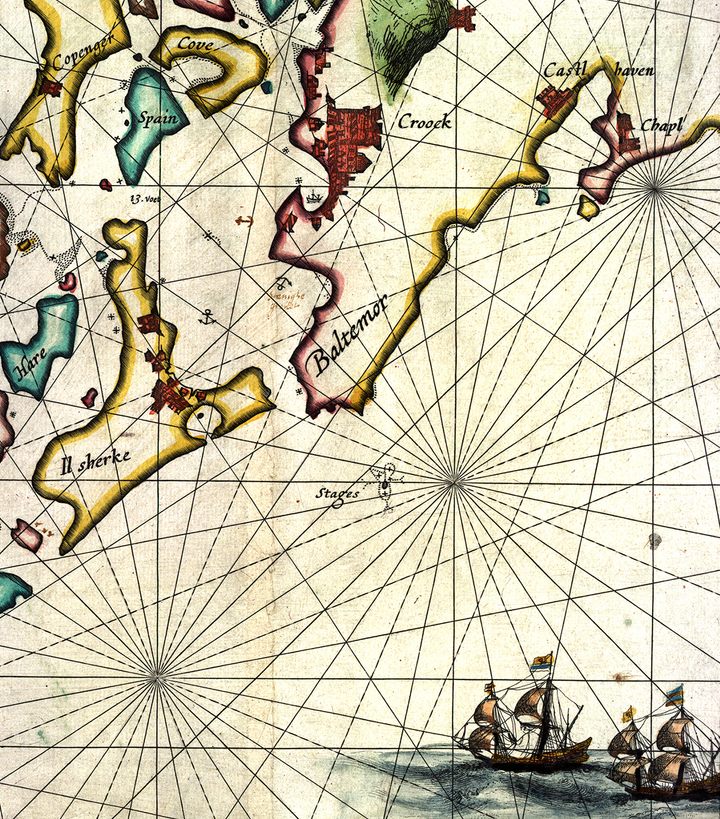
How a Secret Map Brought Down a Pirate Alliance on the Irish Coast
Now archaeologists are using it to search for evidence of clandestine activity.
On a dark night early in the 17th century, a group of men gathered atop the seaside cliffs outside of Castlehaven, a small village on the southwestern coast of Ireland. The flickering light from their lanterns revealed a hidden stairway cut directly into the rock, which they carefully descended down to the sea. Placing their lanterns into two small niches that had also been hollowed out of the rock, the men waited. From the darkness, a ship slowly emerged and drifted, silently, toward them.
Visiting the same location today, now known as Dutchman’s Cove, with its eroded and worn steps and niches, it is easy to imagine such clandestine activity taking place. “Given its remote and hidden position, Dutchman’s Cove was an ideal location for pirate and smuggling operations,” explains Connie Kelleher, an underwater archaeologist with Ireland’s National Monument Service.
Kelleher is an expert on a uniquely organized “pirate alliance” that formed in early-17th-century Ireland and preyed on ships laden with cargo and treasure throughout the North Atlantic. Nearly unstoppable in their day, these pirates met their demise in 1614, in large part due to a devastating attack by a Dutch fleet guided by a leeskarte—a set of navigational instructions with charts of the Irish coastline, created specifically to detail the locations of such pirate havens.
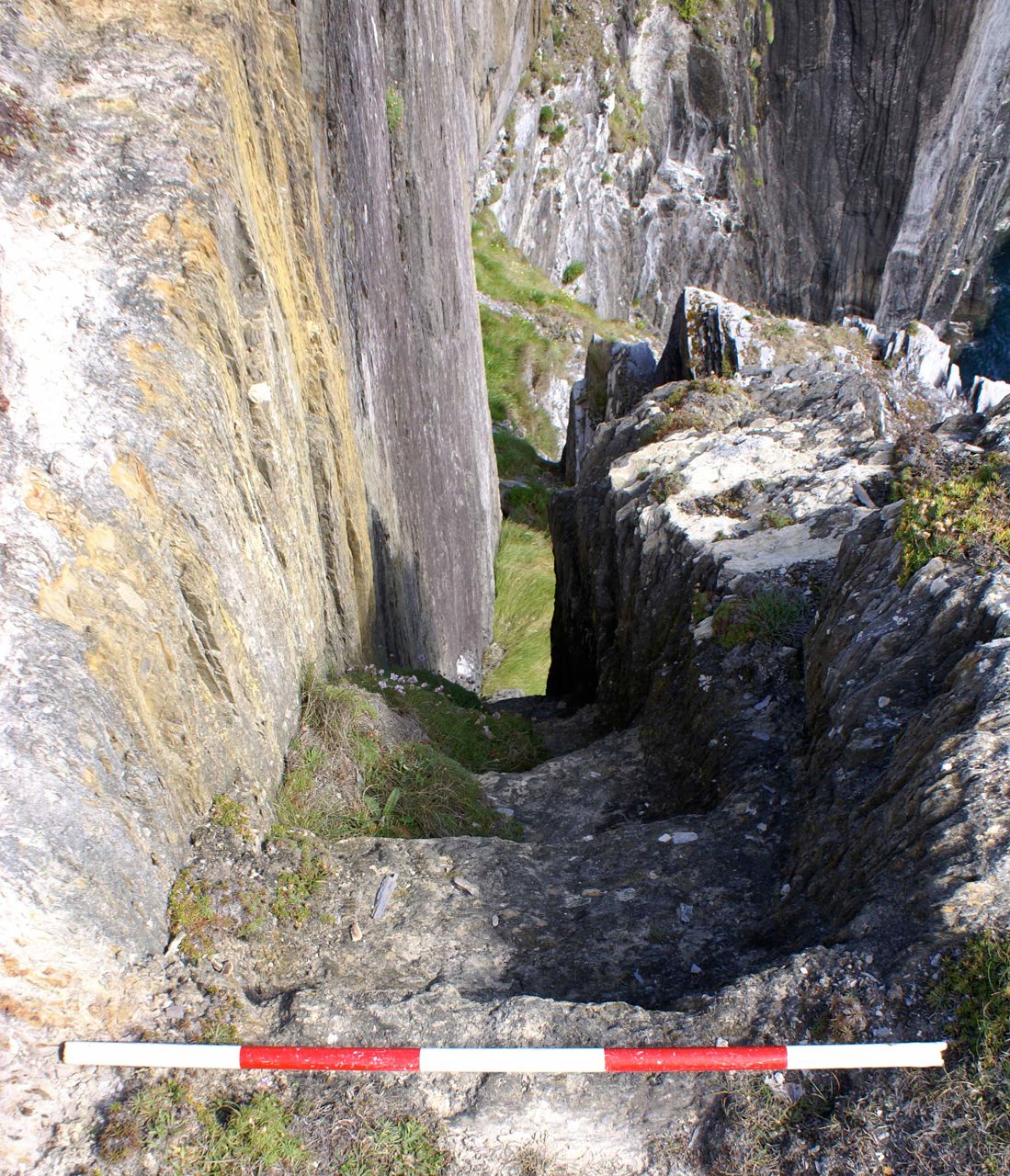
Critically, for Kelleher, the leeskarte they used—an example of which she studied at the University of Göttingen in Germany—not only reveals pirate locations, but also depicts shoreline features and cultural landmarks from the time. “It is a type of ‘treasure map’ informing on the heritage within the landscape at the time,” she says, “which could potentially help us identify other pirate-related locations, including archaeological sites.”
The story of the leeskarte began in 1604, when James I of England ended the long English naval tradition of “privateering” as part of a peace agreement with Spain. Previously, privateers, mariners commissioned by the English Crown to attack merchant ships from enemy countries, were allowed to split their captured loot between themselves, their sponsors, and the Crown itself. Privateering was highly profitable, and kept English ports filled with valuable goods and cargo. Though it was risky work, many sailors preferred it to more official service on the King’s ships, which offered low pay, poor sanitary conditions, and an aging fleet. Over time, English privateers grew in numbers, with the more successful commanding well-armed fleets of multiple ships.
“Privateering in England was considered to be a respectable way to earn a living on the high seas,” says Kelleher. “But as a consequence of the decision by James I [to end the practice], thousands of mariners suddenly found themselves out of work. Used to operating independently, they became prime targets to drift into piracy.” Unsanctioned piracy, that is.
English officials based in southwest Ireland encouraged ex-privateers to join them as part of the “Munster Plantation,” a colonization program in which English settlers were offered cheap land to populate the area, making it less likely to rebel against the English Crown. “Faced with tough job prospects, mariners began moving to southwest Ireland either individually or with their families,” says Kelleher. “However, they were not driven by patriotism or politics. As experienced mariners, they would have seen it as logistically the best place to continue their business.”
Drawing on contemporary sources, Kelleher estimates that up to 1,000 of these men established bases in the towns of Baltimore, Crookhaven, and Leamcon (near the town of Schull) in western County Cork. The geography there was ideal for their purposes, with the harbors, inlets, and islands of the Irish coastline lending themselves to secret haunts and fast escapes. They were also closely positioned to the main Atlantic waterways, where ships from most European nations could be targeted on either their outward or homeward journeys.

Word spread. Dutch, French, Flemish, Scottish, and even African renegades traveled to Ireland to join their English counterparts. Largely as a result of their background as privateers, with some former naval officers and sailors among them, this collection of mariners was unusually organized and formed an “alliance,” with their own rules and hierarchy. They formally elected ex-privateer Richard Bishop to serve as their “admiral,” the ruthless Peter Easton, known for throwing his captives overboard to drown, as “vice-admiral,” and Thomas Francke as “rear-admiral.”
“Bishop’s positive reputation allowed him to act as a broker for the alliance with outside parties, while Easton provided a serious intimidation factor,” says Kelleher, who also estimates that the fully formed “alliance” comprised between 300 and 500 ships, with 72 “captains” so far identified serving underneath Bishop, Easton, and Francke. Capable of operating either independently or as a unit, they sailed in light but heavily manned and armed ships. A favored technique was to approach unsuspecting targets by masquerading as a merchant ship before launching a stunning surprise attack in close quarters.
As they returned to Irish shores, the pirates found eager buyers for their spoils. Exotic goods such as ivory, wine, lace, rare timber, and extremely coveted spices such as nutmeg, cinnamon, and pepper were quickly fenced at quayside auctions. Brothels and taverns began to appear to cater to this maritime trade, with some more than likely operated by pirate wives or widows. To help keep the native Irish population on their side, pirates bought supplies from locals at inflated prices. “Officials often turned a blind eye or became active pirate supporters themselves,” says Kelleher. “Those that didn’t were typically intimidated with threats or paid off with bribes.”
The pirates developed an impressive support and trading network as they sailed from Ireland and Newfoundland in the North Atlantic to the “Barbary” states of North Africa. Documentary evidence of their activity can be difficult to come by as their land activities generally reflected other commerce from the time, while the ocean swallowed up most physical traces of their seaside activity. “Pirates leave little archaeological trace as they were secretive and transitory by nature,” explains Fritz Hanselmann, director of the Underwater Archaeology Program at the University of Miami. “And the tools of their trade such as wood, rope, or canvas also quickly disintegrate.”
Complicating matters further, one pirate shipwreck site usually has little in common with another. “Identifying pirate shipwrecks is often an exercise in standardization,” says Hanselmann. “For example, a British ship of the line is generally outfitted with the same types of armaments throughout its class, whereas a pirate ship generally carries mixed types of armaments they likely picked up along the way. Pirate ships also tend to carry a strong assortment of international goods.
“We try to match what we discover at sites together with recorded testimonials or archival research, such as a mention of where a ship sank, or a description of a pirate lair in the area,” he says. The leeskarte is the rare tool which could not only help to locate pirate sites on land left mostly unscathed from coastal erosion, but also to find more about their activities that were never documented in the first place.
Even though they easily outnumbered any passing patrol ships from the King’s fleet, members of the alliance appear to have observed an unofficial code that was probably part honor, part holdover from the privateer days, part self-preservation, and part good business: They only attacked ships belonging to traditional enemies of England. As a result, shipping and trade for Spain, Portugal, and the Netherlands were constantly interrupted or lost due to their activities. “The majority of the pirates considered themselves to be honorable men who remained loyal to the English Crown, in spite of their treatment by James I,” says Kelleher. “As a practical matter, their attacks on England’s enemies helped to further the cause of England’s expanding empire, and essentially helped to keep the full measure of the Crown’s attention off their backs.”
In 1612, having grown tired of the ongoing pirate harassment, the Dutch government lobbied James I for permission to enter the harbors of southwest Ireland to attack the pirates themselves. James I agreed, but only under the conditions that the pirates would be captured alive and handed over, along with captured goods, to the Kings’ ships to be transported for trial by the Admiralty in England.
To prepare their ships for the attacks, Dutch hydrographer Hessel Gerritszoon was tasked with mapping the Irish coastline with a special focus on the “pirate coast” of southwestern Ireland. A large task in front of him, Gerritszoon engaged English cartographer John Hunt to assist.
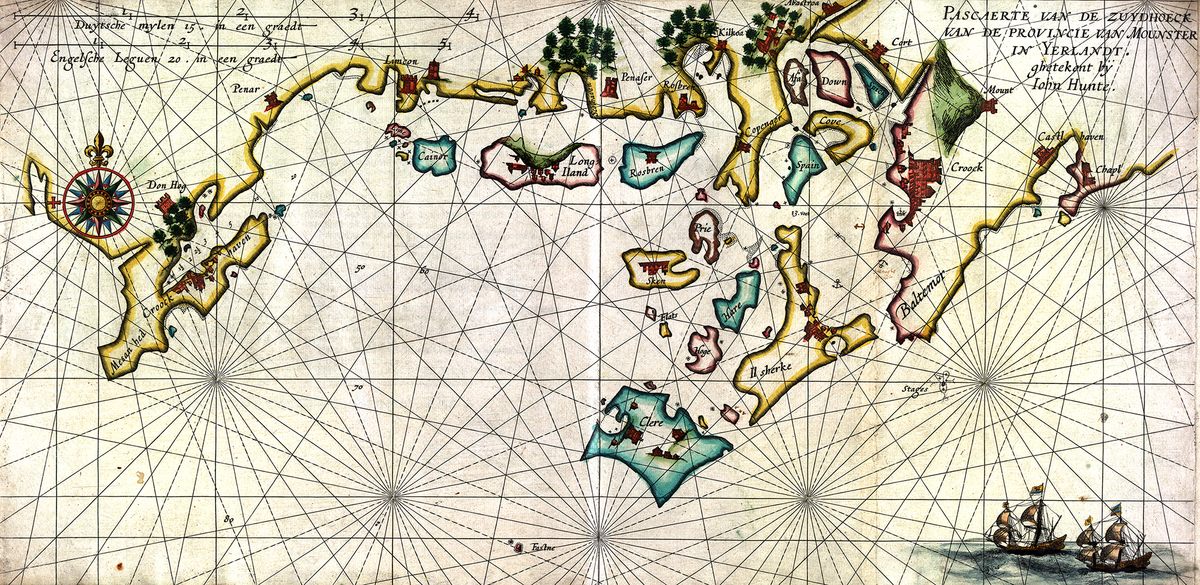
Gerritszoon and Hunt had to proceed cautiously, and carried on most of their work in low-key secrecy, namely to not tip off the pirates, but for other reasons as well. “The establishment of trading enterprises like the Dutch East India Company, as well as colonial expansions, meant that seafaring charts were highly prized,” says Kelleher. “Countries went to great lengths to create them, as well to prevent them from being seen or acquired by others.”
Mapmakers of the time relied heavily on earlier maps produced by other cartographers, often copying and simultaneously updating them with new information from their own travels or other trusted sources. “Though we don’t know how much first-hand knowledge Gerritszoon and Hunt had in advance of drafting the leeskarte, they would have incorporated details solicited from a trusted network of cartographers, sailors, and explorers with contemporary knowledge of Ireland,” says Kelleher.
The completed leeskarte is a complete map of the entire Irish coastline, with four additional charts, the most in-depth of which focuses on the ports of the southwestern coast. It includes such details as the depth ranges in the harbors, anchorages, fortifications, and even the specific locations of pirates and their ships. “Gerritszoon, Hunt, and their colleagues included any details that could be spotted from the sea,” Kelleher says, “likely having done so covertly.”
But there were other motives afoot, and the Dutch couldn’t let a good opportunity pass them by. Gerritszoon and Hunt also mapped key Irish harbors on other parts of the island. “These ‘non-pirate charts’ act as a clue to other Dutch intentions, which was to access the eastern and southern coasts of Ireland as potential trade areas,” says Kelleher. “The Dutch were among the leading cartographers of the time and sought to maintain their edge in this regard.”
Written in Old Dutch, the leeskarte is housed today in the library at the University of Göttingen in Germany, which acquired it in the mid 1700s as part of a larger collection of books. Kelleher rediscovered it several years ago, after coming across a 1935 source during her research. Intrigued, she traveled to Göttingen to pour over the leeskarte in person, and “was gobsmacked as I opened it to find that it was produced in full color.”
Kelleher has used the chart of the southwest coast to identify or confirm pirate-related sites, including ones illustrated with ruins that can still be clearly seen today, such as castles, churches, anchorages, harbor facilities, and settlement areas. In other cases, time has completely worn away the above-ground evidence, for at least six sites depicted. But it does take some interpretation, like any good treasure map.
“Using the leeskarte as a guide from a boat today, it is clear that it was drafted from the sea, as this clarifies better the oblique nature of the illustration and visible inaccuracies,” says Kelleher. “But what is critical from our cultural heritage perspective is that it does provide illustrative evidence for sites not previously recorded. For instance, we know from written sources that a castle once stood in the middle of Crookhaven town, and a large fortified structure also existed in Leamcon. Upstanding remains for both structures have long since disappeared, so the chart serves to confirm these sites within the landscape.”
In 1614 the Dutch, aided by the completed leeskarte, sailed into the harbor at Crookhaven and attacked the pirate base there. Caught by surprise, the pirates were forced to abandon their ships by jumping into the sea, and were brutally cut down as they swam ashore. Irish pirate Patrick Myagh, who captained the fleet, and two of his sons were killed, as well as 28 others, along with English officials on shore. It wasn’t what James I had bargained for.
As Myagh’s 180-ton ship burned, the Dutch raided it for its valuable cargo. “As the Myagh family was a well-known merchant family, the Dutch may have been partly motivated to attack due to economic factors,” says Kelleher. “They went too far in their attack, as they were commissioned by James I to capture the pirates alive.
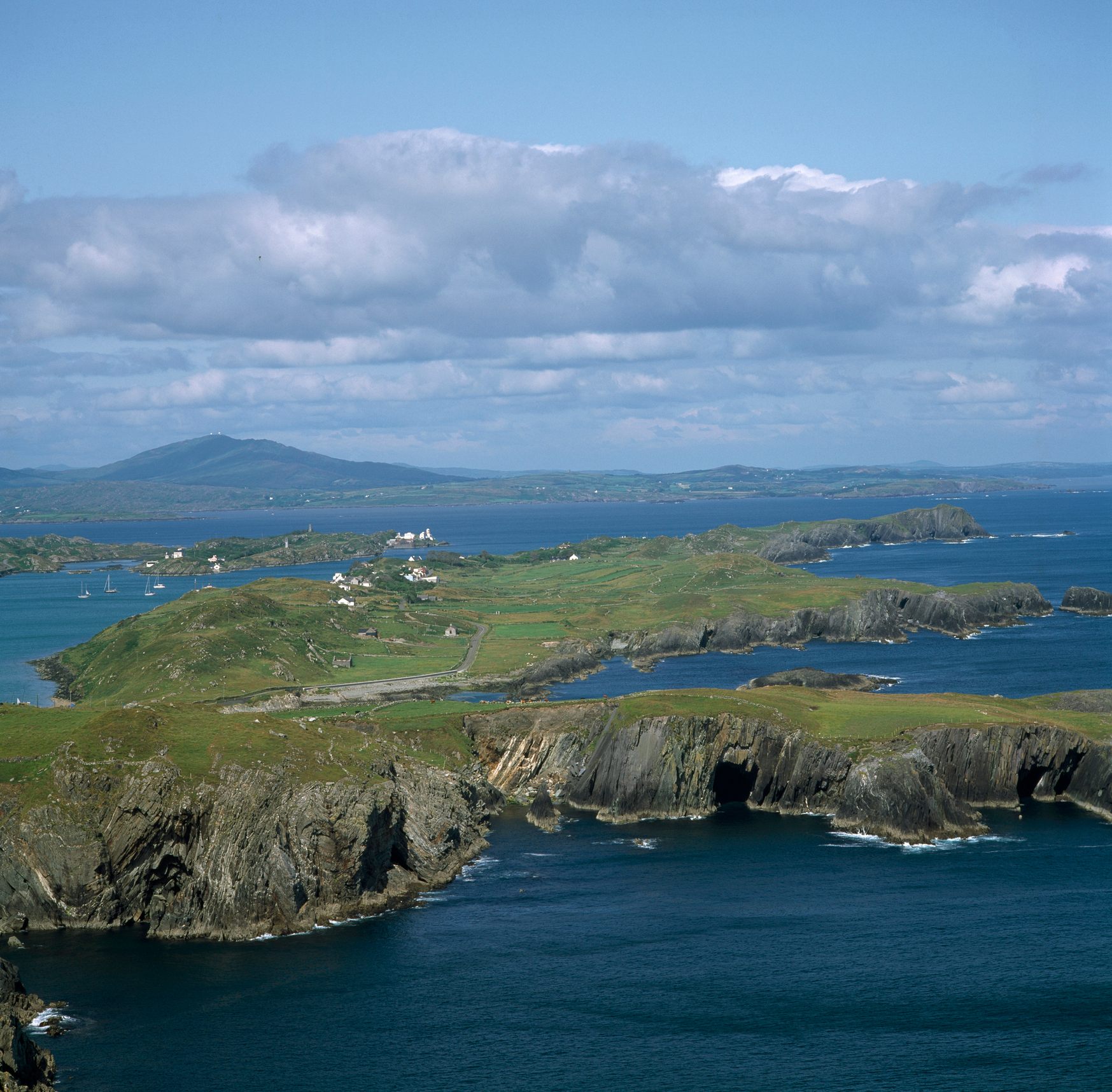
“They ignored this and essentially ‘turned pirate’ themselves, attacking pirate and non-pirate alike in what turned into a massacre.”
The Crookhaven attack was a serious blow to the alliance. On top of the pressure from the Dutch, other factors were working against them. The Crown began enforcing legislation that allowed pirates to be tried and executed in Ireland. North African pirates, such as the Algerian Turks and Barbary Corsair, were aggressively expanding their operations into the alliance’s territory. And the English Navy began to rebuild itself, galvanized in part by Henry Mainwaring, a former pirate who published a “tell-all” book that caused a public sensation in England. And Crookhaven itself was only the beginning of the Dutch offensive.
“From about the year 1612, Richard Bishop and his pirate fleet had been attacked several times by the Dutch,” says Kelleher, “and many pirates began to consider alternatives to their illicit profession.”
Some began to actively seek pardons from James I, who eventually decided it was easier to deal with the pirates as part of the fold instead of outside of it. He offered to pardon the pirates, even allowing them to hold on to their stolen goods, and by 1616, many had gone this route. Others chose to leave North Atlantic waters to practice their trade elsewhere while those who stayed melted into the fabric of southwest Ireland. Bishop, contemporary sources suggest, constructed his own house “in the English fashion” in Leamcon. Others became legitimate merchants in the fast-growing trade in preserved salted fish. Still more joined ship crews pioneering new trade routes to the New World and the East and West Indies.
Kelleher hopes that the leeskarte will lead her and others to more pirate-era discoveries similar to sites such as Dutchman’s Cove. She works with locals near known areas of pirate activity to identify other sites that may be connected to the alliance, and continues to survey the Irish coastline personally to search for new evidence. One intriguing find is another secluded series of steps located near the entrance to Crookhaven Harbor, connected to a cavern large enough to have allowed a ship’s smaller boat to enter and offload goods. “Such sites can date to any period and have multiple uses,” she says. “As they are unexcavated it is difficult to date them specifically, but they would certainly have been used by pirates and smugglers at some point.” She has also identified similar recesses and carved steps on Sherkin Island, just off the coast of Baltimore. “Other finds, like shards of a 17th-century Tuscan oil jar recovered from the foreshore near Leamcon, is indicative of continental trade to such remote areas. One has to wonder if it was possibly brought in on a pirate ship?”

Kelleher is especially intrigued by what is not so visible, but beneath the waves of the North Atlantic. There are up to 12 pirate-associated ships known to have been lost around the “pirate coast,” including those destroyed in the 1614 Crookhaven attack. “More than likely, the wrecked ships were salvaged following the attack, but it is certainly possible that remains of the hulls, smaller artifacts, and other elements of the ships could still be there, along with possible guns, anchors, cables, and even cargo that was in the hold,” she speculates.
“Early charts are windows into our past, and the leeskarte presents a rare opportunity to investigate what could be considered, at a particular point in time, a ‘pirate landscape.’ The search for the cultural footprint of these men forms part of the enduring intrigue that pirates continue to have,” says Kelleher, whose passion for the subject recently led her to write a full-length book on the alliance.
“It’s fascinating to examine these charts today as an early example of marine mapping. With little archaeological work having been done so far at many of the pirate-related sites, it is exciting to consider what else the leeskarte can reveal and what other secrets it has to offer.”





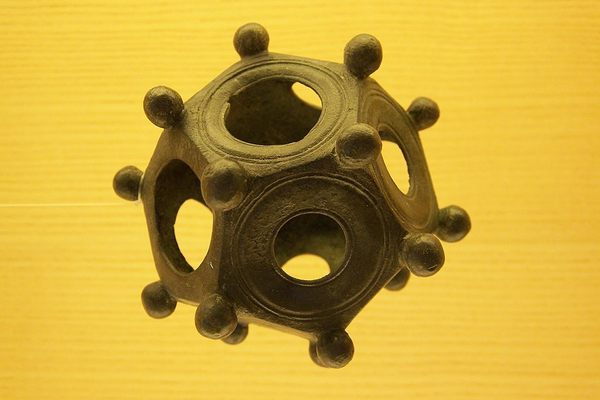
























Follow us on Twitter to get the latest on the world's hidden wonders.
Like us on Facebook to get the latest on the world's hidden wonders.
Follow us on Twitter Like us on Facebook